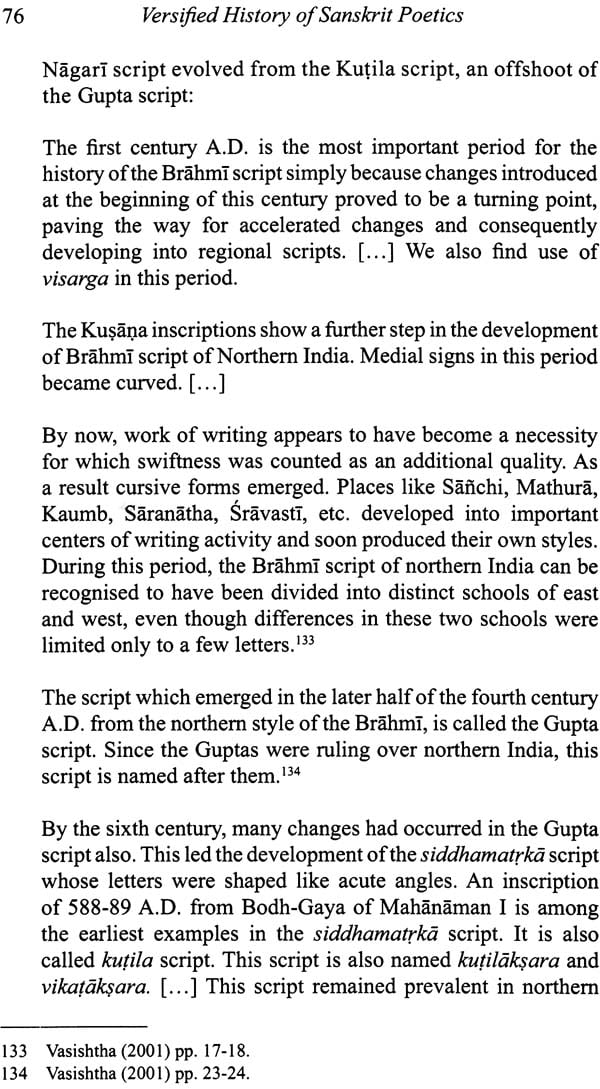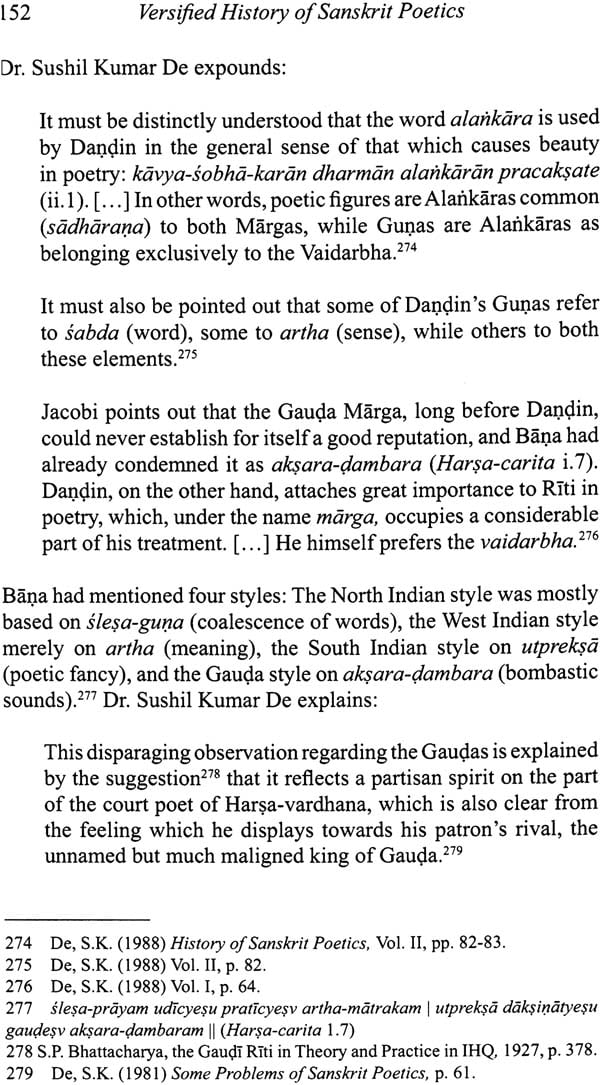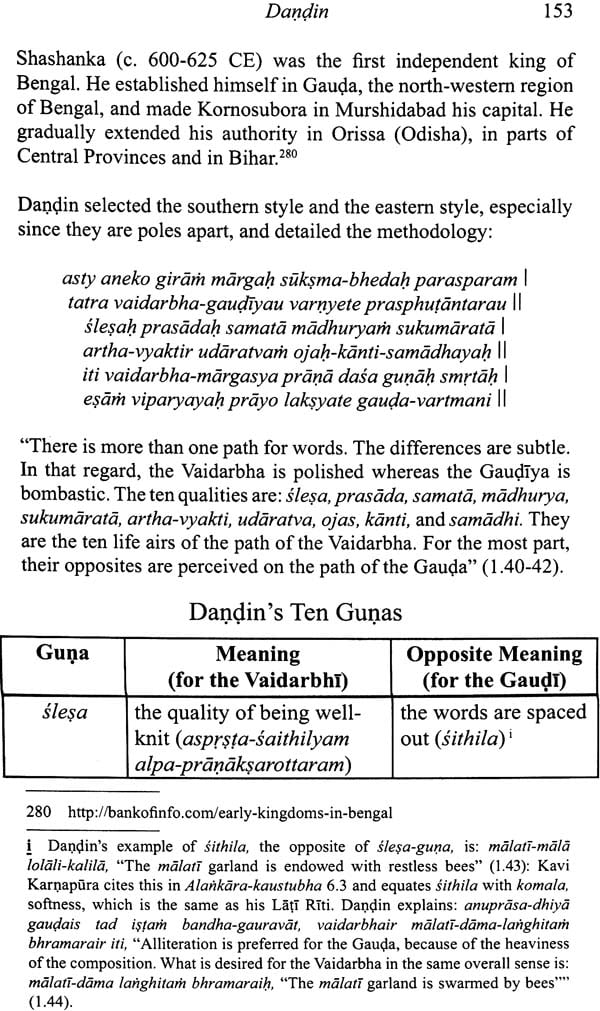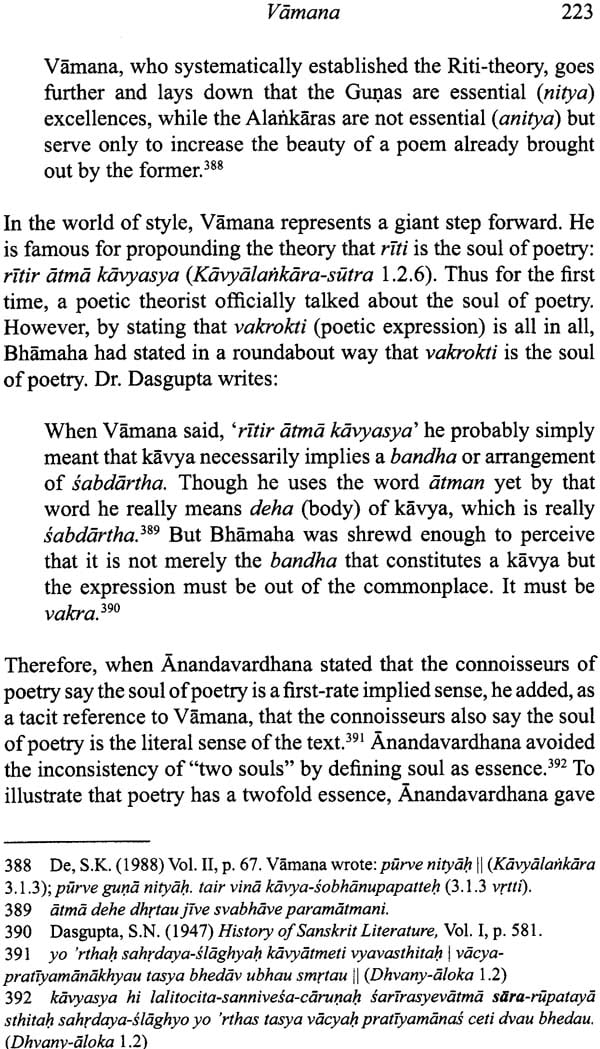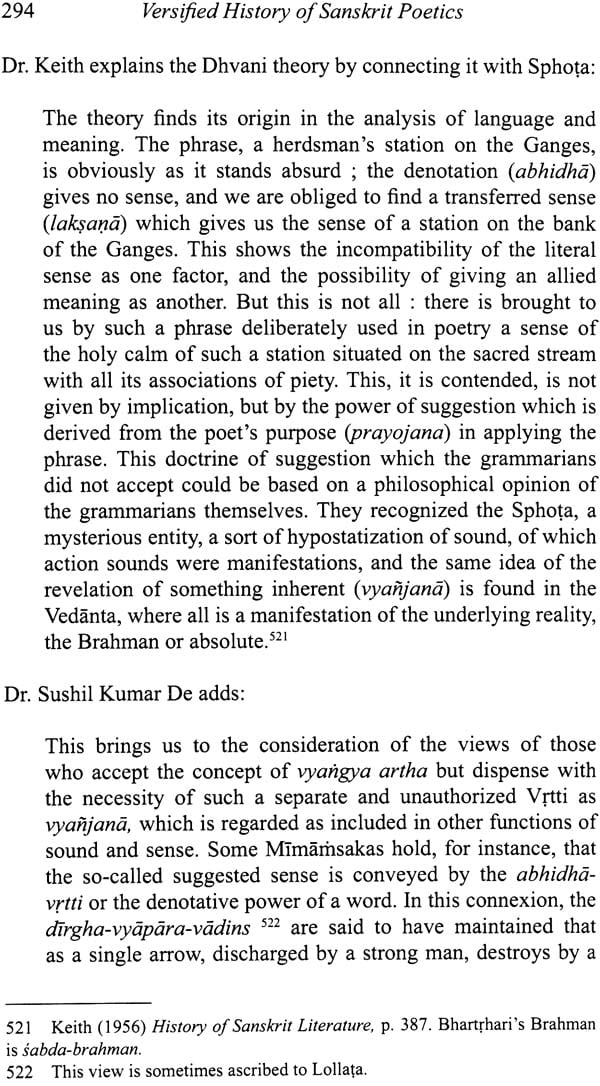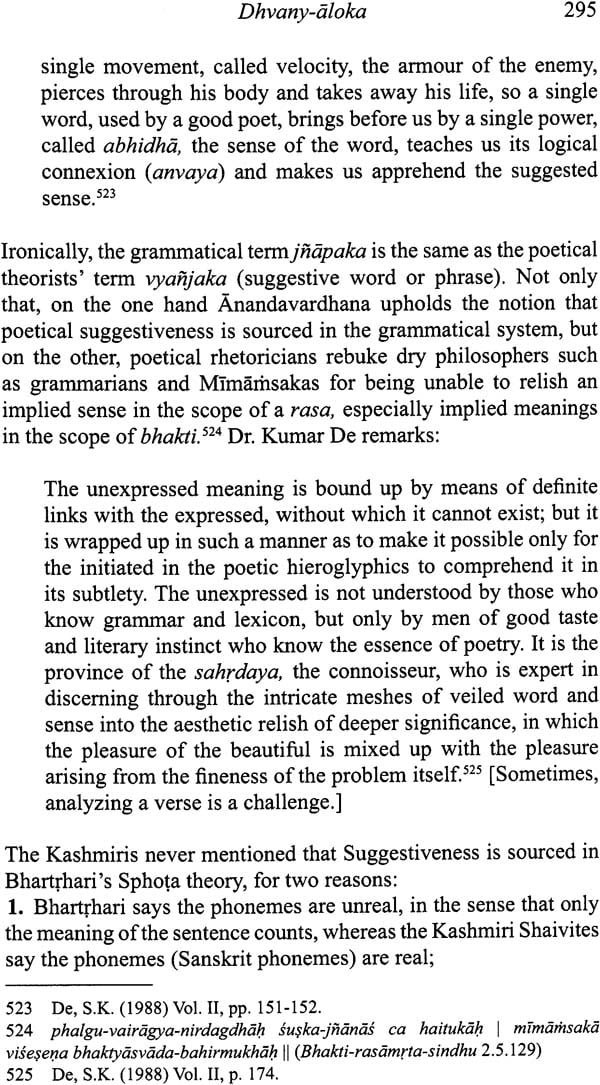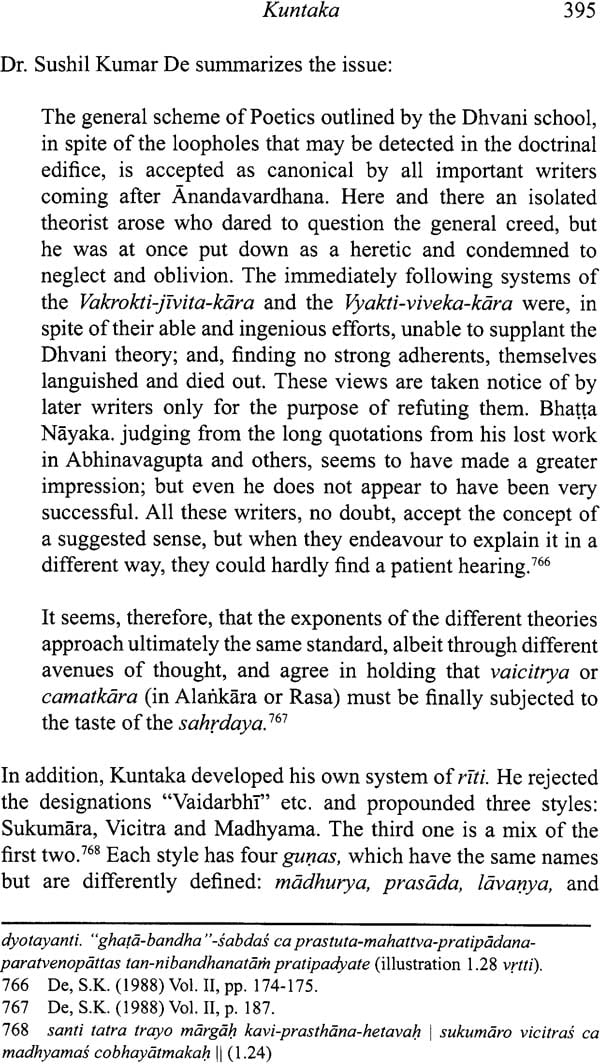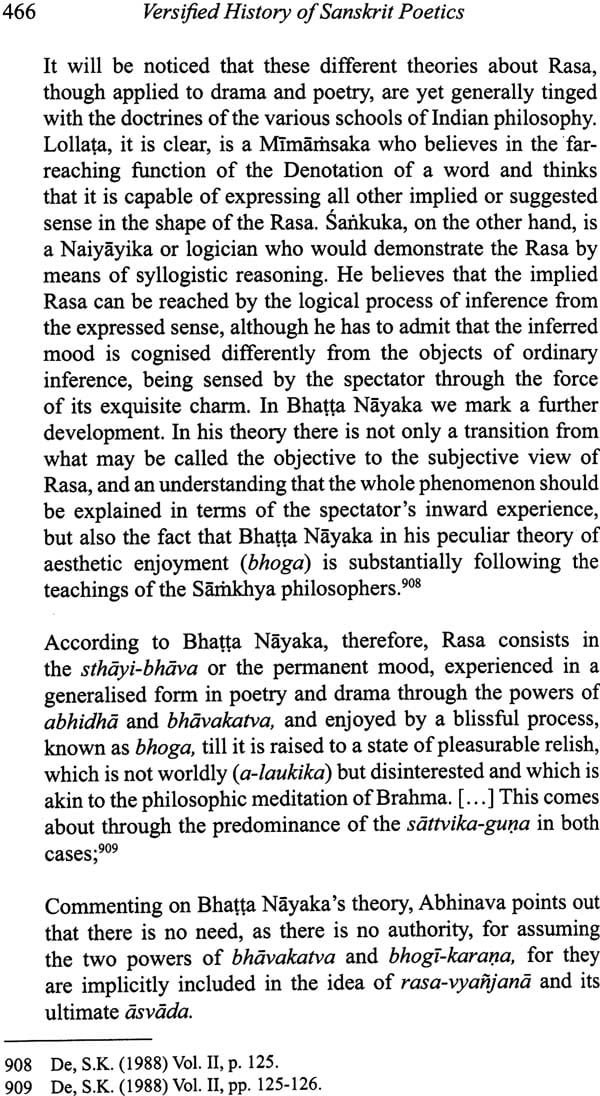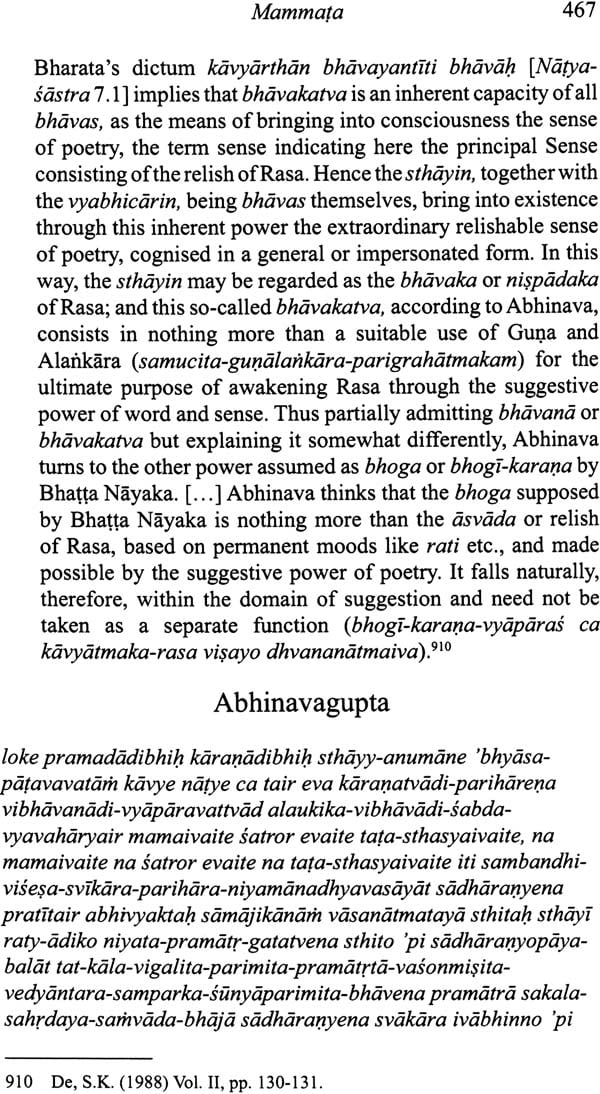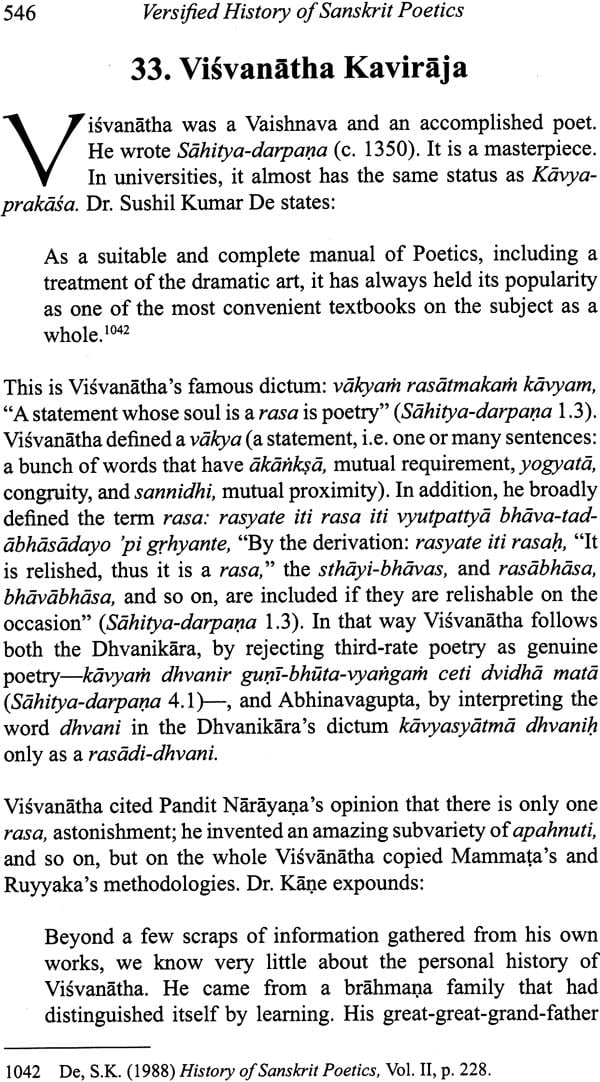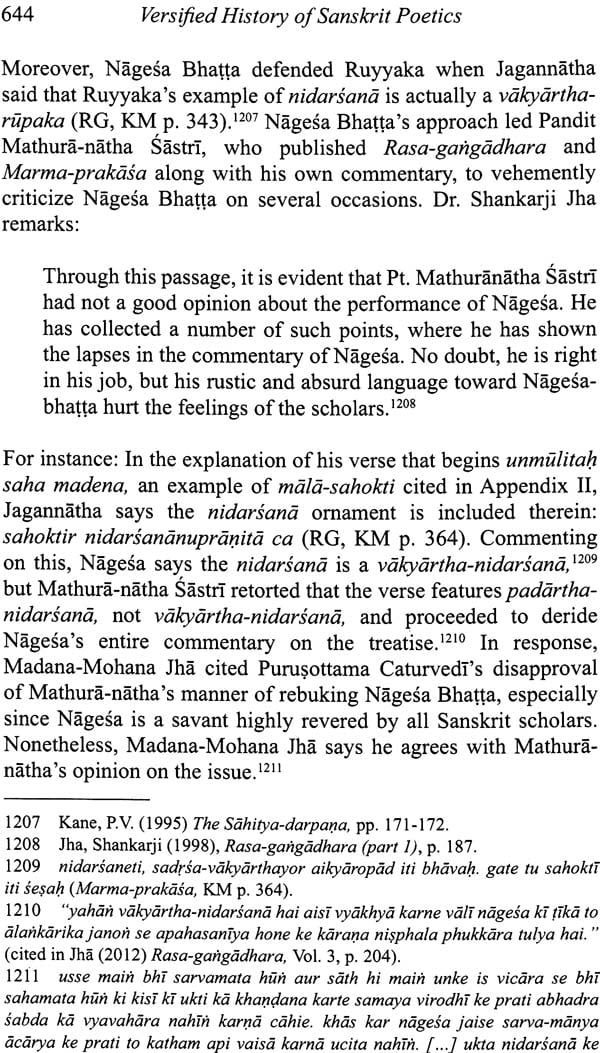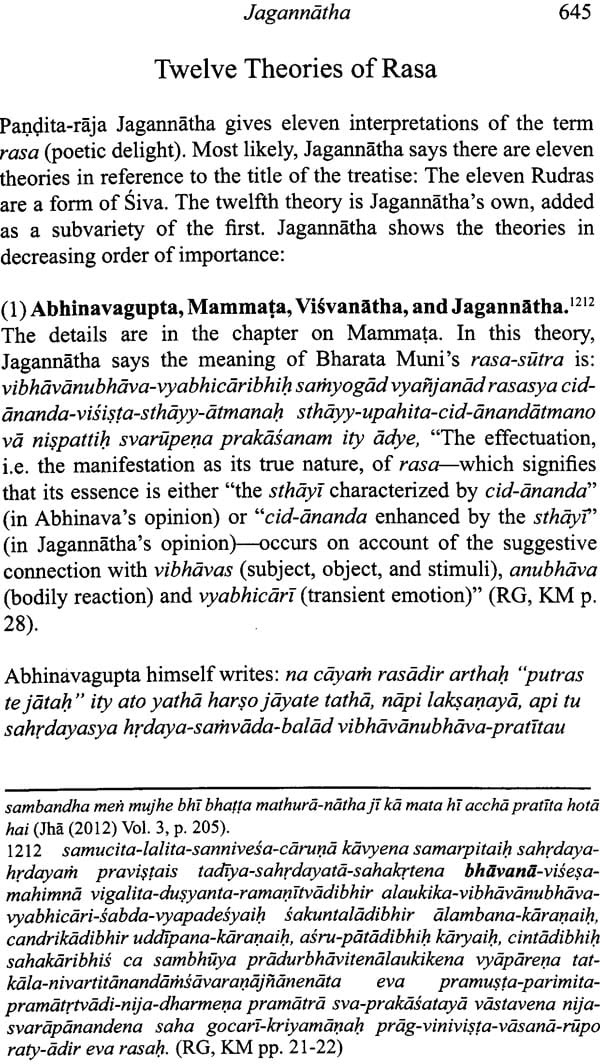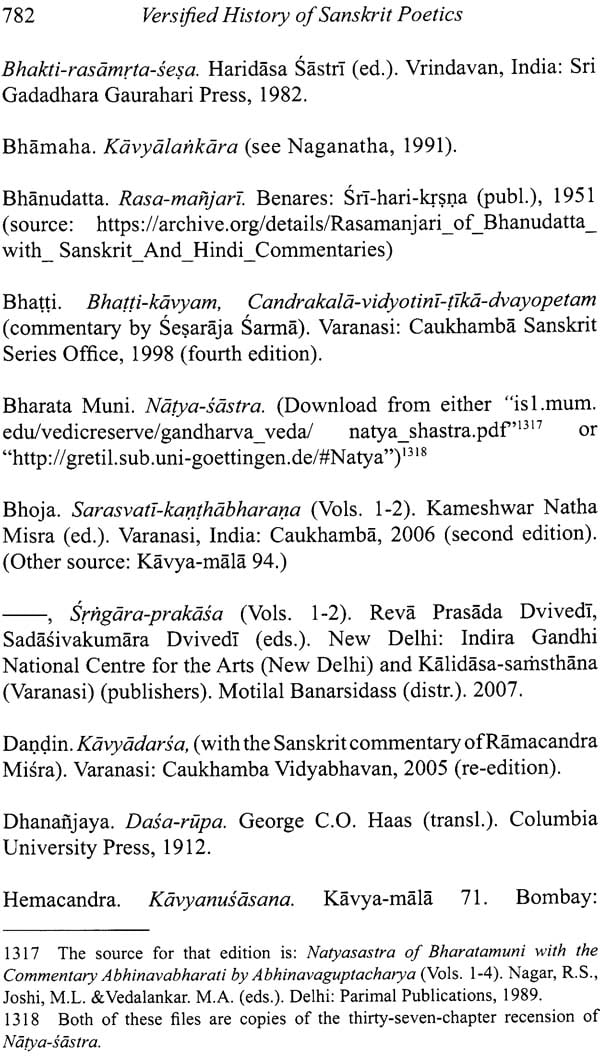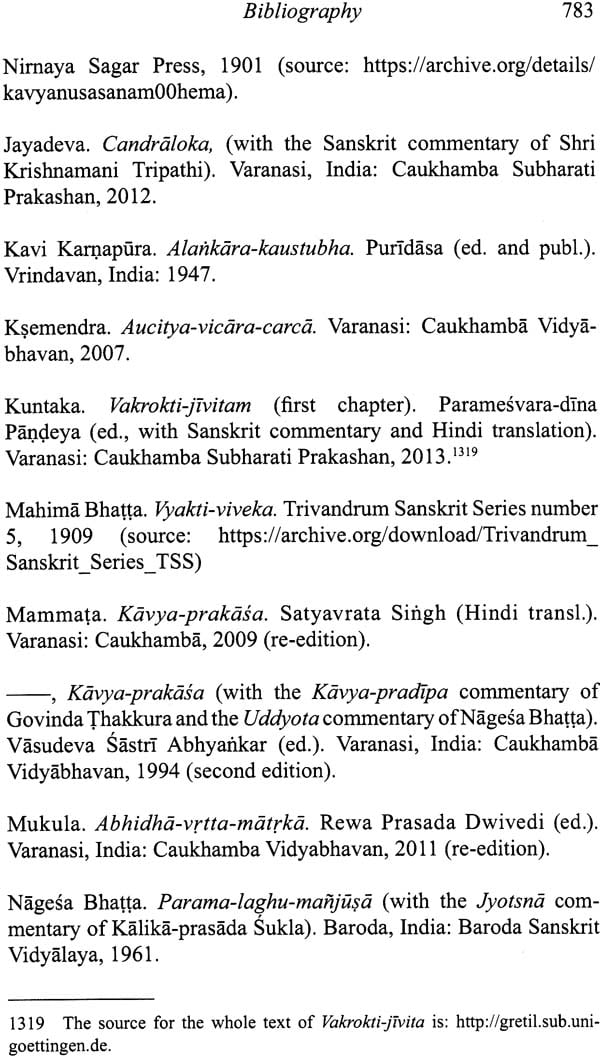
Versified History of Sanskrit Poetics: The Soul is Rasa
Book Specification
| Item Code: | NAN691 |
| Author: | Gaurapada Dasa |
| Publisher: | RAS BIHARI LAL AND SONS |
| Language: | English |
| Edition: | 2017 |
| ISBN: | 9788184030433 |
| Pages: | 790 |
| Cover: | Hardcover |
| Other Details | 8.5 Inch X 5.5 Inch |
| Weight | 1.10 kg |
Book Description
Gaurapada began studying Sanskrit grammar in a traditional Indian environment: under the tutelage of his Grace Gopi- parana-dhana Prabhu, he completed the three- years course at Srimad bhagavata- vidta- pitham, in Govardhana: He learned jiva Gosvami’s grammatical treatise Hari- namamrta- vyakarana in depth and edited matsya avatara’s translation of it. In addition to his master’s degree in Sanskrit, Gaurapada holds a degree in science and is a certified chef.
Introduction
Poetry is the artistic use of words that evokes our mojo. Like other forms of art, poetry is meant to give us the astonishing sense of "wow". The poetic theory refined by Sanskrit rhetoricians, such as the Dhvani theory and the ornaments of meaning, also apply to other languages, given that the Sanskrit rhetoricians' methodology of analysis is universal. But Sanskrit is especially well-suited: It is the best medium for poetry because Sanskrit phonemes are distinctly pure, because Sanskrit is favourable for double meanings and because it is based on a rich tradition.
The highest aesthetic experience is a type of self-realization: Pandita-raja Jagannatha remarks: cid eva rasah, "The spirit soul is Rasa." The word rasa often means "aesthetic delight," but in this context Rasa means rapture: the mix of transcendental bliss and astonishment. It is up to us to take the steps to realize this.
Sanskrit poets wrote for scholars. Dr. Keith notes:
The neglect of Sanskrit Kavya is doubtless natural. The great poets of India wrote for audiences of experts; they were masters of the learning of their day, long trained in the use of language, and they aim to please by subtlety, not simplicity of effect. They had at their disposal a singularly beautiful speech, and they commanded elaborate and most effective metres. Under these circumstances it was inevitable that their works should be difficult, but of those who on that score pass them by it may fairly be said ardua dum metuunt amittunt vera viai.
This Latin maxim by Lucertius means: “They fear while it is arduous. They lose the true path.” Some Sanskrit rhetoricians promulgated secular poetry; others, such as Anandavardhana, Visvanatha Kaviraja and Pandita-raja Jagannatha, hinted that bhakti is the ultimate goal of life; and yet other theorists, including Rupa Gosvami and Kavi Karnapura, used poetry to promulgate bhakti, but in all instances the underlying purpose of studying poetry is to realize that symbolism is an essential aspect of life. The study of poetic expression makes us think outside the box, gives us a feel for symbolism and, with logical reasoning, enables us to read the signs in day-to-day life. God communicates indirectly and reciprocates in accordance with His dictum: ye yatha mam prapadyante tdms tathaiva bhajamy aham, "I serve them in the same way they devote themselves to Me" (Bhagavad-gita 4.11). Sanskrit poetics perfectly mixes art and philosophy.
Although his friends lead him to his beloved, if she does not recognize him as her lover she will view him like she views any other man, and so he could not possibly take pleasure with her. Similarly, even though the Lord is directly related to oneself, the soul, if His qualities are unnoticed His glory will remain imperceptible. On this analogy is established the usage of the term Pratyabhijna in philosophy.
Abhinavagupta explains: jnatasyapi visesato nirupanam anusandhanatmakam atra pratibhijnanam, na tu tad evedam ity etdvan-matram, "Pratyabhijna is not simply the ordinary recognition "That is that." Rather it is a realization involving a deeper understanding of what is known in a general way" (Locana 1.8). This was Abhinavagupta's comment on Anandavardhana's statement that a great poet is one who is able to recognize which sounds and which meanings can give rise to a first-rate implied sense. Ultimately, poets make us ponder over the nature of real love.
Like the Sanskrit language itself, Sanskrit poetics is very systematic. Rajasekhara says the knowledge of poetical theory is necessary to correctly interpret Vedic texts. In addition, he says poetics forms a seventh Vedanga (auxiliary branch of learning). The Upanisads and other scriptures on Vedanta philosophy are founded on poetic expression.
Figurative usage is a main feature of poetics. This book is called "Versified" History of Sanskrit Poetics because it abounds in verses: The best stanzas of each poetical rhetorician are shown so that the history of the evolution of the concept of rasa is apparent. Moreover, in the section on Anandavardhana is a dissertation on the Dhvani theory and on its prototype, Sphota-vada, which are the apex of the philosophy of language. Other specialties lacking in previous books in the field of the history of Sanskrit poetics include citra-kavya diagrams, the evolution of the scripts, the rise of the concept of bhakti, the distinct contributions of Vaishnavas, a discussion on the mystical basis of poetics (the soul is Rasa), and comparisons between Sanskrit poetics and English poetics. The nectar of all related books is found here. Over and above that, the chapter on Pandita-raja Jagannatha and Appendix II, which include his best examples, constitute a succinct rendering of Rasa- gangadhara, the most influential treatise on Sanskrit poetics in modem times.
Contents
| INTRODUCTION | 7 | |
| PREAMBLE | ||
| The origin of poetry | 19 | |
| The poetical derivation of the term sloka | 19 | |
| The development of literature | 25 | |
| The greats of Sanskrit literature | 26 | |
| The definition of a masterpiece | 28 | |
| The secondary greats of Sanskrit literature | 29 | |
| The grandmasters of Sanskrit poetic theory | 37 | |
| The six schools of Sanskrit poetics | 38 | |
| The customary topics in a treatise on poetics | 40 | |
| Kashmir | 43 | |
| The purpose of poetry | 50 | |
| The evolution of the classification of bhakti | 53 | |
| Poetesses | 54 | |
| Anthologies | 59 | |
| One simile seen through the prism of Alankara | 60 | |
| The documented origins of Sanskrit poetic theory | 62 | |
| Panini | 67 | |
| The evolution of the scripts | 72 | |
| The possible influence of greek dramaturgy | 80 | |
| The Sanskrit language | 88 | |
| THE BEST THEORIES AND EXAMPLES OF THE POETICAL THEORISTS | ||
| 1 | Bharata Muni (Natya-sastra) | 91 |
| Eight rasas | 95 | |
| Four literary ornaments | 97 | |
| Ten gunas | 101 | |
| Thirty-six kavya-laksanas | 104 | |
| Table of the Kavya- Laksanas | 107 | |
| Differences between natya-rasa and kavya-rass | 114 | |
| The theme of each chapter | 118 | |
| Bharata's sons are cursed and come to Earth | 123 | |
| Two recensions | 130 | |
| Commentaries and tradition | 133 | |
| 2 | Visnu-dharmottara Upapurana | 135 |
| 3 | Bhatti (Bhatti-kdvya) | 137 |
| 4 | Dandin (Kavyadarsa) | 144 |
| Sequence of topics | 150 | |
| Ten gunas | 153 | |
| Ornaments of meaning | 158 | |
| Ornaments of sound | 172 | |
| 5 | Medhavin | 184 |
| 6 | Bhamaha | 187 |
| Sequence of topics | 189 | |
| Ornaments | 196 | |
| 7 | Udbhata | 202 |
| Ornaments of sound | 205 | |
| Ornaments of meaning | 209 | |
| 8 | Vamana | 217 |
| Sequence of topics | 218 | |
| Ritis and gunas | 222 | |
| Table of Vamana's Twenty gunas | 227 | |
| Ornaments | 233 | |
| 9 | Rudrata | 238 |
| Vakrokti | 239 | |
| Ritis and vrttis | 241 | |
| Yamaka | 243 | |
| Citra-kavya | 247 | |
| Ornaments of meaning | 257 | |
| Rasa | 263 | |
| 10 | Anandavardhana (Dhvany-alokai | 265 |
| First-rate poetry | 275 | |
| Second-rate poetry | 279 | |
| The origins of the concept of implied meaning | 281 | |
| Dhvani in grammar: The Kashmiris' burden of proof | 285 | |
| Patanjali's theory of Sphota | 287 | |
| Bhartrhari's theory of Sphota | 298 | |
| Philosophy influences poetic theory | 319 | |
| The Kashmiri Shaivite tradition | 320 | |
| The evolution of the Dhvani theory | 339 | |
| Miscellaneous topics | 348 | |
| 11 | Bhatta Nayaka (Hrdaya-darpana) | 349 |
| 12 | Rajasekhara (Kavya-mimamsa) | 359 |
| 13 | Mukula Bhatta (Abhidha-vrtti-matrkd) | 368 |
| Diagrams of figurative usage | 370 | |
| 14 | Abhinavagupta | 373 |
| 15 | Dhananjaya | 382 |
| 16 | Kuntaka | 388 |
| 17 | Agni Purdna | 396 |
| 18 | Bhoja | 404 |
| Sarasvati- Kanthabharana | 406 | |
| Sources | 407 | |
| Gunas | 410 | |
| Ornaments | 415 | |
| Rasa | 423 | |
| Srngara-prakasa | 427 | |
| 19 | Rudra Bhatta | 436 |
| 20 | Ksemendra | 439 |
| 21 | Mahima Bhatta | 445 |
| 22 | Mammata | 455 |
| Four theories of rasa Lollata | 458 | |
| Sankuka | 460 | |
| Nayaka | 464 | |
| Abhinavagupta | 467 | |
| Two meanings of rasa | 471 | |
| Ornaments of meaning | 474 | |
| Yamaka | 476 | |
| The two authors of Kavya- Prakasa | 482 | |
| 23 | Ruyyaka | 485 |
| 24 | Hemacandra | 493 |
| 25 | Sridhara Svami | 495 |
| Supplement on Laksmidhara | 501 | |
| 26 | Vag- Bhata I | 503 |
| 27 | Vag- Bhata II | 504 |
| 28 | Jayadeva | 506 |
| 29 | Vopadeva | 513 |
| The Grammatical treatises Post- Astadhyayi | 517 | |
| The purpose of writing the Mukta- Phala | 520 | |
| Sequence of topics | 522 | |
| Eighteen subdivision of Bhakti | 527 | |
| Supplement on Madhusudana Sarasvati | 528 | |
| 30 | Vidyadhara | 532 |
| 31 | Vidyanatha | 534 |
| Sequence of topics | 537 | |
| 32 | Singa-bhupala | 540 |
| 33 | Visvanatha Kaviraja | 546 |
| The kings of Orissa | 548 | |
| The meaning of Sahitya-darpana | 551 | |
| The derivation of the term srngara | 552 | |
| Illustrative examples | 552 | |
| The Sweetness os Dr. Kane | 556 | |
| The differences between Sahitya-darpana and Kavya- Prakasa | 556 | |
| 34 | Bhanu Datta | 559 |
| 35 | Rupa Gosvami | 566 |
| 36 | Jiva Gosvami | 571 |
| 37 | Kavi Karnapura | 577 |
| Yamaka | 580 | |
| Citra-kavya | 582 | |
| Rasa | 585 | |
| 38 | Kesava Misra | 591 |
| 39 | Appaya Diksita | 594 |
| 40 | Pandita- Raja Jagannatha | 600 |
| Definition of Poetry | 612 | |
| Four categories of Poetry | 616 | |
| Features of Rasa-gangiidhara | 620 | |
| Criticism | 630 | |
| Jagannatha and Nagesa | 638 | |
| Twelve theories of rasa | 645 | |
| The last great Sanskrit poet | 655 | |
| 41 | Krishna Kavi (Mandara-maranda-campu) | 661 |
| 42 | Visvesvara Pandita (Alankiira-kaustubhay | 667 |
| 43 | Baladeva Vidyabhusana | 669 |
| The Soul is Rasa | 670 | |
| AFTERWORD | ||
| Einstein's three stages of religion | 677 | |
| Synchronicity | 685 | |
| APPENDIX I | ||
| The best of Bhartrhari's three centuries | 689 | |
| Niti-sataka | 691 | |
| Srngara-sataka | 694 | |
| Vairagya-sataka | 700 | |
| A verse of vakrokti by Ratnakara | 702 | |
| APPENDIX II | ||
| Illustrative examples by Pandita-raja Jagannatha | 705 | |
| APPENDIX III | ||
| Mythology in Hinduism | 747 | |
| APPENDIX IV | ||
| COMPARISONS BETWEEN SANSKRIT POETICS AND ENGLISH POETICS | 751 | |
| Technical differences between English Poetics and Sanskrit Poetics | 756 | |
| APPENDIX V | ||
| Tribute to Kalidasa | 763 | |
| GLOSSARY | 769 | |
| SANSKRIT PRONUNCIATION GUIDE | 777 | |
| BIBLIOGRAPHY | ||
| Primary texts | 781 | |
| Translations and studies | 787 |
Sample Pages
